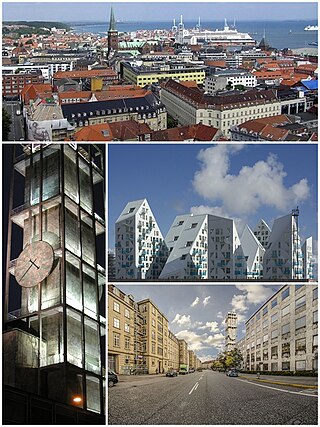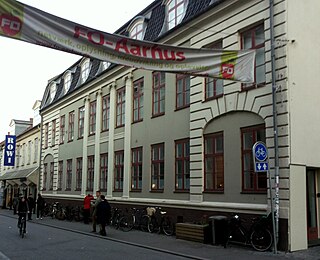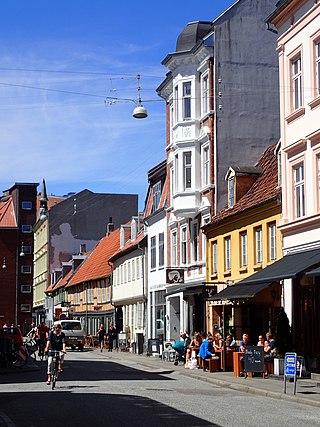
Aarhus is the second-largest city in Denmark and the seat of Aarhus Municipality. It is located on the eastern shore of Jutland in the Kattegat sea and approximately 187 kilometres (116 mi) northwest of Copenhagen.

Transport in Denmark is developed and modern. The motorway network covers 1,111 km while the railway network totals 2,667 km of operational track. The Great Belt Fixed Link connecting the islands of Zealand and Funen and the New Little Belt Bridge connecting Funen and Jutland greatly improved the traffic flow across the country on both motorways and rail. The two largest airports of Copenhagen and Billund provide a variety of domestic and international connections, while ferries provide services to the Faroe Islands, Greenland, Iceland, Germany, Sweden, and Norway, as well as domestic routes servicing most Danish islands.

Assens is a town with a population of 6,061 on the west coast of the island of Funen on the eastern side of the Little Belt in central Denmark. By road, Assens is located 41.2 kilometres (25.6 mi) southwest of Odense, 34 kilometres (21 mi) northwest of Faaborg, and 33.34 kilometres (20.72 mi) southeast of Middelfart. Assens is the municipal seat of Assens Municipality in Region of Southern Denmark. It was the birthplace of sculptor Jens Adolf Jerichau who married the well-known portraitist Elisabeth Jerichau-Baumann; both artists' works are exhibited at the local art museum, Vestfyns Kunstmuseum.

Randers is a city in Randers Municipality, Central Denmark Region on the Jutland peninsula. It is Denmark's sixth-largest city, with a population of 64,057. Randers is the municipality's main town and the site of its municipal council. By road it is 38.5 kilometres (23.9 mi) north of Aarhus, 43.8 kilometres (27.2 mi) east of Viborg, and 224 kilometres (139 mi) northwest of Copenhagen.

Christian Frederik Møller, generally referred to as C. F. Møller, was a Danish architect, professor and, from 1965 to 1969, the first rector of the Aarhus School of Architecture. His former practice, Arkitektfirmaet C. F. Møller, which he founded in 1924, still exists and bears his name. It is today the largest architectural firm in Denmark with branch offices in several countries.

Jutland is a peninsula of Northern Europe that forms the continental portion of Denmark and part of northern Germany (Schleswig-Holstein). It stretches from the Grenen spit in the north to the confluence of Elbe and Sude in the southeast. The historic southern border river of Jutland as a cultural-geographical region, which historically also included Southern Schleswig, is the Eider. The peninsula, on the other hand, also comprises areas south of the Eider: Holstein, the former duchy of Lauenburg, and most of Hamburg and Lübeck.

Grenaa is a Danish town and seaport on the east coast of the Jutlandic peninsula. Tourism, education and commerce are important sectors in the economy of Grenaa. It is the only larger town on Djursland. Grenaa is the municipal seat, and the largest town, in Norddjurs Municipality, which covers the northern half of Djursland.

Rasmus Otto Mønsted was an industrialist and margarine manufacturer from Denmark.

The Port of Aarhus is a deep-sea port located in the city of Aarhus. It is the largest container port in Denmark, handling more than 50% of country's container traffic. The Port of Aarhus shipped roughly 8.4 million metric tonnes of cargo in 2017.

Aarhus Oliefabrik A/S was a company and oil mill in Aarhus, Denmark. Established in 1871 it was one of the largest employers and exporters in the city through the late 19th and early 20th centuries.

Nordre Cemetery is a cemetery in Aarhus, Denmark. It was established in 1876, east of Aarhus University and Aarhus University Hospital by Nørrebrogade.

Herskind's House is a house and a listed building in Aarhus, Denmark. The house was built in approximately 1850 and was listed on the Danish registry of protected buildings and places by the Danish Heritage Agency on 2 October 1970. The house is situated in the historic Indre by neighborhood on Frederiksgade, close to the City Hall.

Mønsted's House is a house and a listed building in Aarhus, Denmark. The house was built in 1810 and was listed on the Danish registry of protected buildings and places by the Danish Heritage Agency on 24 March 1950. The building is situated in the historic Indre by neighborhood on Vestergade across from the Church of Our Lady. The reason for the listing was partly the historical significance and importance of the building and the impact of its former inhabitants.

Vestergade is a street in Aarhus, Denmark, which runs east to west from the central square of Store Torv to the city park of Åparken at Carl Blochs Gade, intersecting the main streets of Grønnegade and Vester Allé along its course. Vestergade begins in the Indre By neighborhood and ends in neighborhood of Vesterbro, close to CeresByen. Vestergade has some of the best preserved 18th-century merchant estates in Aarhus and a history of creativity and artistic expression.
Hans Wilhelm Schrøder was a Danish architect.

Park Allé is a street in the Indre By district in Aarhus, Denmark which runs north to south from Sønder Allé to Banegårdspladsen. Park Allé is a major bus hub and is home to the Aarhus City Hall, the City Hall Square and the two large hotels of The Mayor Hotel and Hotel Ritz.

Frederik Marius Draiby was a Danish architect and the first city engineer of Aarhus. Until his retirement in 1943 Frederik Draiby impacted the architecture in Aarhus through his job where he approved building designs and with several notable buildings of his own designs. The municipal Spanien Public Baths, the harbor warehouse Stykgodspakhuset and Store Kapel on Vestre Cemetery are his best known works although he also worked on urban planning designs.

Korn- og Foderstof Kompagniet (KfK) was a Danish company in the feed-stuffs industry. Founded in Aarhus in 1896 by 12 merchants it grew through the early 20th century to become one of the largest Danish businesses trading in feed-stuffs and grain with branches in many Danish cities. It became one of the largest employers in Aarhus until the 2000s when the grain business was bought by a number of competitors, led by Dansk Landbrugs Grovvareselskab, and renamed Treka. The remainder of KfK was reformed into the company Biomar A/S, focused mainly on fish feed.

Laurits Christian Meulengracht or Laurits Christopher Meulengracht was a Danish businessman and brewer who became one of the wealthiest men in Denmark in the 19th century. He received the Order of the Dannebrog and Knight of the Dannebrog.
Niels Aage Anton Nielsen was a Danish professor of Nordic languages at Aarhus University. He was also a leader in the Danish resistance movement.



















